FELM4026 Spring 2018: Economic & Financial Literacy - UK Analysis
VerifiedAdded on 2023/06/13
|18
|3675
|408
Report
AI Summary
This report provides a comprehensive analysis of key aspects of the UK economy and business environment. It examines the business strategy of Co-op Food, focusing on its marketing tactics and competitive positioning within the oligopolistic supermarket sector. The report further investigates the dynamics of the UK housing market, exploring factors influencing housing demand and supply, and the role of the Bank of England's monetary policy. Additionally, it assesses the macroeconomic performance of the UK over the past five years, analyzing trends in GDP, inflation, interest rates, and unemployment. The report concludes with a discussion of financial leverage and its implications for businesses.
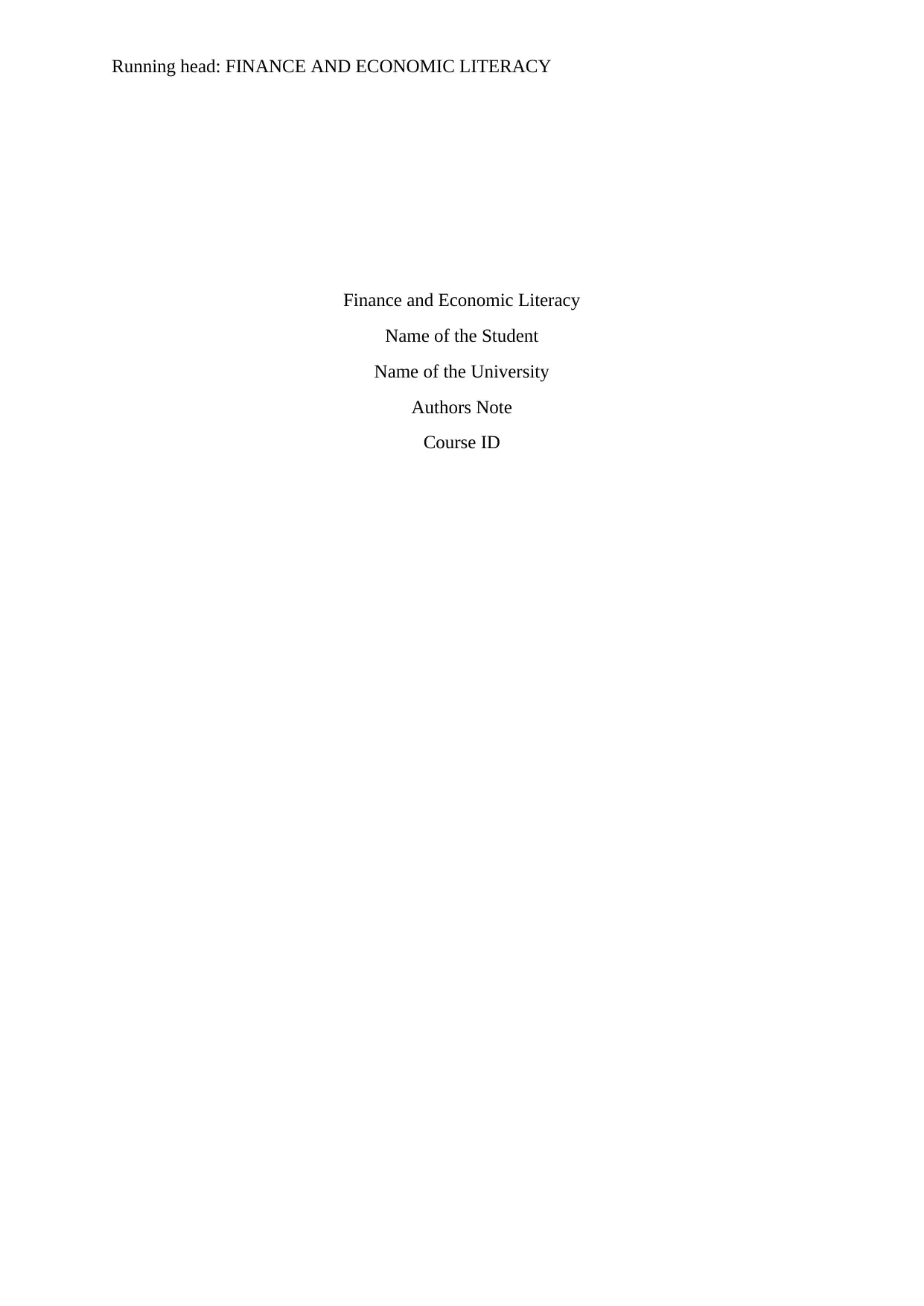
Running head: FINANCE AND ECONOMIC LITERACY
Finance and Economic Literacy
Name of the Student
Name of the University
Authors Note
Course ID
Finance and Economic Literacy
Name of the Student
Name of the University
Authors Note
Course ID
Paraphrase This Document
Need a fresh take? Get an instant paraphrase of this document with our AI Paraphraser
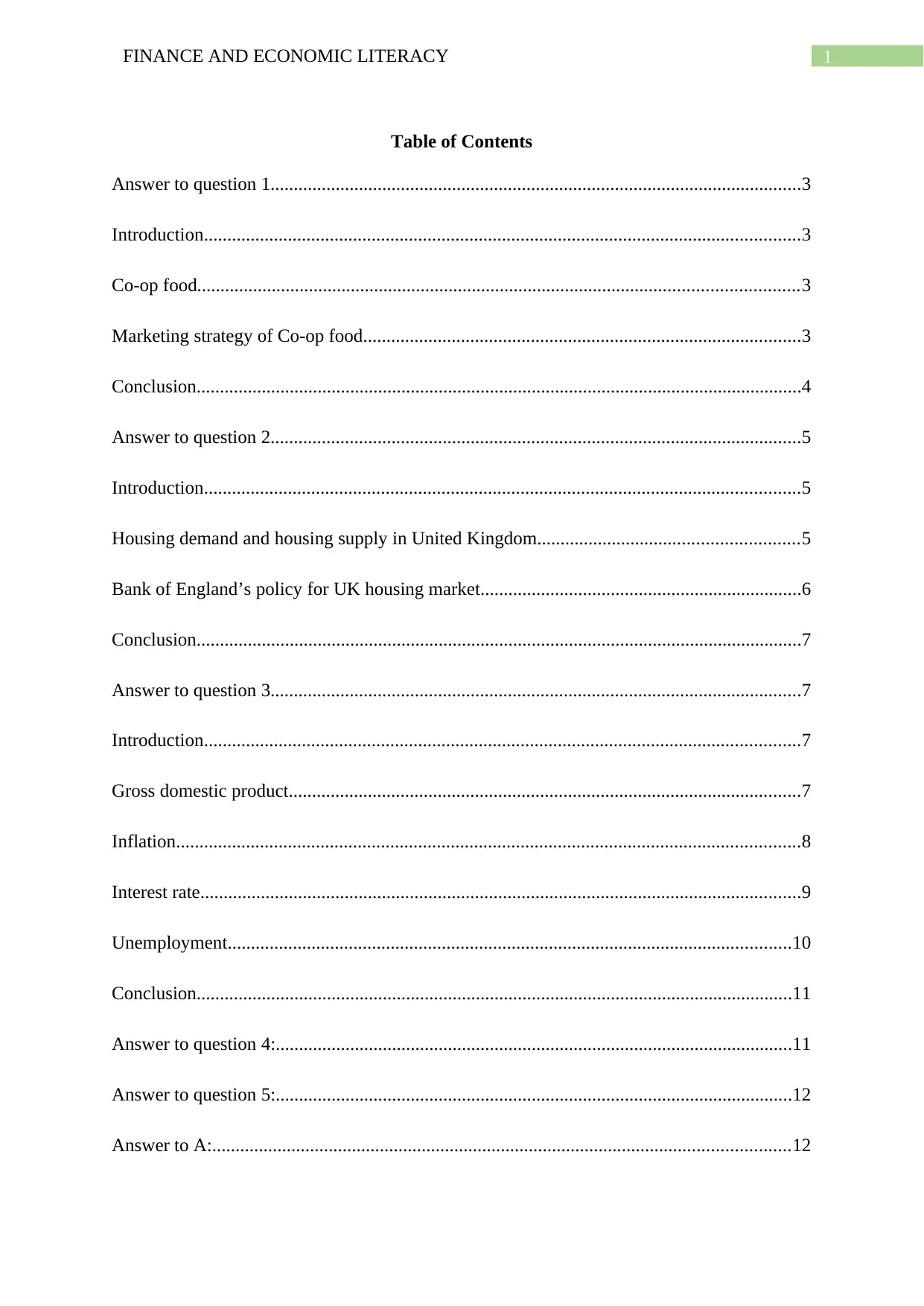
1FINANCE AND ECONOMIC LITERACY
Table of Contents
Answer to question 1..................................................................................................................3
Introduction................................................................................................................................3
Co-op food.................................................................................................................................3
Marketing strategy of Co-op food..............................................................................................3
Conclusion..................................................................................................................................4
Answer to question 2..................................................................................................................5
Introduction................................................................................................................................5
Housing demand and housing supply in United Kingdom........................................................5
Bank of England’s policy for UK housing market.....................................................................6
Conclusion..................................................................................................................................7
Answer to question 3..................................................................................................................7
Introduction................................................................................................................................7
Gross domestic product..............................................................................................................7
Inflation......................................................................................................................................8
Interest rate.................................................................................................................................9
Unemployment.........................................................................................................................10
Conclusion................................................................................................................................11
Answer to question 4:...............................................................................................................11
Answer to question 5:...............................................................................................................12
Answer to A:............................................................................................................................12
Table of Contents
Answer to question 1..................................................................................................................3
Introduction................................................................................................................................3
Co-op food.................................................................................................................................3
Marketing strategy of Co-op food..............................................................................................3
Conclusion..................................................................................................................................4
Answer to question 2..................................................................................................................5
Introduction................................................................................................................................5
Housing demand and housing supply in United Kingdom........................................................5
Bank of England’s policy for UK housing market.....................................................................6
Conclusion..................................................................................................................................7
Answer to question 3..................................................................................................................7
Introduction................................................................................................................................7
Gross domestic product..............................................................................................................7
Inflation......................................................................................................................................8
Interest rate.................................................................................................................................9
Unemployment.........................................................................................................................10
Conclusion................................................................................................................................11
Answer to question 4:...............................................................................................................11
Answer to question 5:...............................................................................................................12
Answer to A:............................................................................................................................12

2FINANCE AND ECONOMIC LITERACY
Answer to B:............................................................................................................................14
Answer to C:............................................................................................................................14
Reference List:.........................................................................................................................16
Answer to B:............................................................................................................................14
Answer to C:............................................................................................................................14
Reference List:.........................................................................................................................16
⊘ This is a preview!⊘
Do you want full access?
Subscribe today to unlock all pages.

Trusted by 1+ million students worldwide

3FINANCE AND ECONOMIC LITERACY
Answer to question 1
Introduction
In UK economy, several business operates successfully positive contribution to
economic growth. The grocery supermarket is one of the widely extended business in UK.
Different sized firms operate in the supermarket chain. The report evaluates business strategy
of Co-op food, one of the grocery retailers in UK.
Co-op food
Co-op Food is a retail grocery brand operated by co-operative group in UK. In 2016,
the company accounted about 6.6% share of grocery market. Despite fall in co-operative
society’s market share from a peak of 30% in 1950 to 6.6% today, it still ranks fifth in the list
of grocery retailers in UK (co-operativefood.co.uk 2018).
The company operates in an oligopolistic market structure. A market is identified as
an oligopoly market when a market with large number of buyers is dominated by only few
large firms (Sloman and Jones 2017). The four dominating players in UK grocery
supermarket are Tesco, Morrison, Sainsbury and Asda.
Marketing strategy of Co-op food
In an oligopoly market, the operating firms take several strategies to capture a higher
market share by undercutting share of its rival. Some of the commonly used strategy
oligopolistic firms include product differentiation, advertising, price war and other specific
strategies (Ashwin, Taylor and Mankiw 2016). Co-op Food has taken some of these strategies
to retain its position in the market.
The company has made a gradual shift towards becoming one of the leading
convenience food retailers in UK. In order to achieve this the company has planned to double
Answer to question 1
Introduction
In UK economy, several business operates successfully positive contribution to
economic growth. The grocery supermarket is one of the widely extended business in UK.
Different sized firms operate in the supermarket chain. The report evaluates business strategy
of Co-op food, one of the grocery retailers in UK.
Co-op food
Co-op Food is a retail grocery brand operated by co-operative group in UK. In 2016,
the company accounted about 6.6% share of grocery market. Despite fall in co-operative
society’s market share from a peak of 30% in 1950 to 6.6% today, it still ranks fifth in the list
of grocery retailers in UK (co-operativefood.co.uk 2018).
The company operates in an oligopolistic market structure. A market is identified as
an oligopoly market when a market with large number of buyers is dominated by only few
large firms (Sloman and Jones 2017). The four dominating players in UK grocery
supermarket are Tesco, Morrison, Sainsbury and Asda.
Marketing strategy of Co-op food
In an oligopoly market, the operating firms take several strategies to capture a higher
market share by undercutting share of its rival. Some of the commonly used strategy
oligopolistic firms include product differentiation, advertising, price war and other specific
strategies (Ashwin, Taylor and Mankiw 2016). Co-op Food has taken some of these strategies
to retain its position in the market.
The company has made a gradual shift towards becoming one of the leading
convenience food retailers in UK. In order to achieve this the company has planned to double
Paraphrase This Document
Need a fresh take? Get an instant paraphrase of this document with our AI Paraphraser
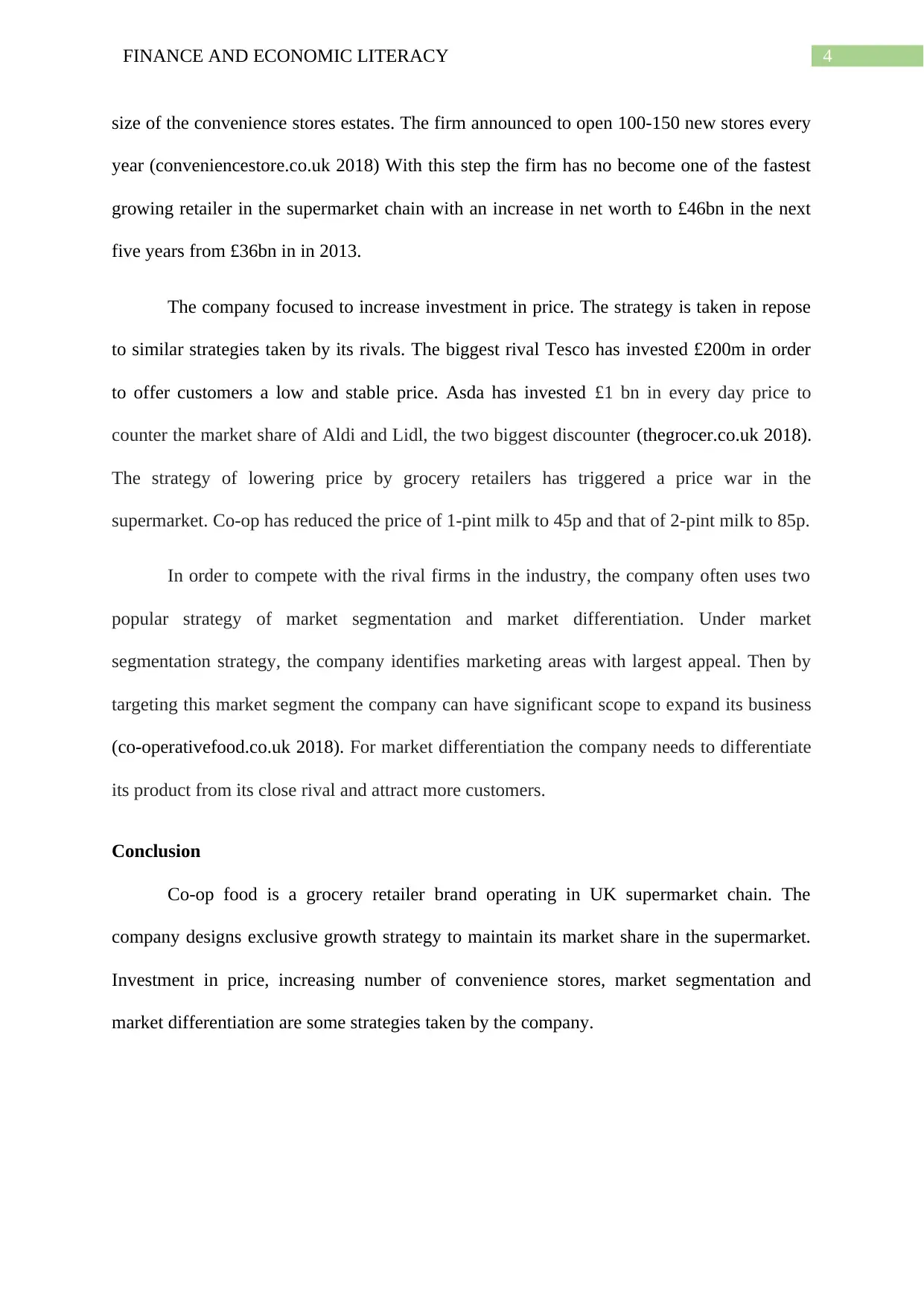
4FINANCE AND ECONOMIC LITERACY
size of the convenience stores estates. The firm announced to open 100-150 new stores every
year (conveniencestore.co.uk 2018) With this step the firm has no become one of the fastest
growing retailer in the supermarket chain with an increase in net worth to £46bn in the next
five years from £36bn in in 2013.
The company focused to increase investment in price. The strategy is taken in repose
to similar strategies taken by its rivals. The biggest rival Tesco has invested £200m in order
to offer customers a low and stable price. Asda has invested £1 bn in every day price to
counter the market share of Aldi and Lidl, the two biggest discounter (thegrocer.co.uk 2018).
The strategy of lowering price by grocery retailers has triggered a price war in the
supermarket. Co-op has reduced the price of 1-pint milk to 45p and that of 2-pint milk to 85p.
In order to compete with the rival firms in the industry, the company often uses two
popular strategy of market segmentation and market differentiation. Under market
segmentation strategy, the company identifies marketing areas with largest appeal. Then by
targeting this market segment the company can have significant scope to expand its business
(co-operativefood.co.uk 2018). For market differentiation the company needs to differentiate
its product from its close rival and attract more customers.
Conclusion
Co-op food is a grocery retailer brand operating in UK supermarket chain. The
company designs exclusive growth strategy to maintain its market share in the supermarket.
Investment in price, increasing number of convenience stores, market segmentation and
market differentiation are some strategies taken by the company.
size of the convenience stores estates. The firm announced to open 100-150 new stores every
year (conveniencestore.co.uk 2018) With this step the firm has no become one of the fastest
growing retailer in the supermarket chain with an increase in net worth to £46bn in the next
five years from £36bn in in 2013.
The company focused to increase investment in price. The strategy is taken in repose
to similar strategies taken by its rivals. The biggest rival Tesco has invested £200m in order
to offer customers a low and stable price. Asda has invested £1 bn in every day price to
counter the market share of Aldi and Lidl, the two biggest discounter (thegrocer.co.uk 2018).
The strategy of lowering price by grocery retailers has triggered a price war in the
supermarket. Co-op has reduced the price of 1-pint milk to 45p and that of 2-pint milk to 85p.
In order to compete with the rival firms in the industry, the company often uses two
popular strategy of market segmentation and market differentiation. Under market
segmentation strategy, the company identifies marketing areas with largest appeal. Then by
targeting this market segment the company can have significant scope to expand its business
(co-operativefood.co.uk 2018). For market differentiation the company needs to differentiate
its product from its close rival and attract more customers.
Conclusion
Co-op food is a grocery retailer brand operating in UK supermarket chain. The
company designs exclusive growth strategy to maintain its market share in the supermarket.
Investment in price, increasing number of convenience stores, market segmentation and
market differentiation are some strategies taken by the company.

5FINANCE AND ECONOMIC LITERACY
Answer to question 2
Introduction
In the last 25 years, housing market in UK had undergone as a serious crisis. In 2007,
housing price reached to the highest level relative to earnings. Price have particularly risen in
London and the South. In determining housing price, the supply and demand of housing play
an important role.
Housing demand and housing supply in United Kingdom
Factors affecting housing demand
Affordability: The first primary determinants of housing demand is the affordability. In time
of economic growth, average income increases leading to an increases in affordability and
housing demand. In UK, housing prices have increased at a much faster rate than
affordability does (Kim 2015).
Interest rate: Interest rate is an important factor determining housing affordability. Higher
interest rate reduces affordability causing a decline in demand. The average interest rate in
UK was at around 4.5% until 2008. After 2008, interest rate reduced drastically. During this
time, interest rate had reached to a recorded low level. The interest rate had remained since
then had remained at 0.5% (Zhang et al. 2017) The mortgage rate however did not fall in line
with the interest rate as many lenders targeted to maintain their stock of liquidity to increases
profitability. Additionally, fixed borrowers cannot take the advantage of low interest rate. In
2009, the variable rate of mortgage fell to 3.8%.
Credit availability: The demand for property depends on available credit. During financial
crisis of 2008-09, the credit supply has declined causing an associated decline in housing
demand and price (Kim 2015).
Answer to question 2
Introduction
In the last 25 years, housing market in UK had undergone as a serious crisis. In 2007,
housing price reached to the highest level relative to earnings. Price have particularly risen in
London and the South. In determining housing price, the supply and demand of housing play
an important role.
Housing demand and housing supply in United Kingdom
Factors affecting housing demand
Affordability: The first primary determinants of housing demand is the affordability. In time
of economic growth, average income increases leading to an increases in affordability and
housing demand. In UK, housing prices have increased at a much faster rate than
affordability does (Kim 2015).
Interest rate: Interest rate is an important factor determining housing affordability. Higher
interest rate reduces affordability causing a decline in demand. The average interest rate in
UK was at around 4.5% until 2008. After 2008, interest rate reduced drastically. During this
time, interest rate had reached to a recorded low level. The interest rate had remained since
then had remained at 0.5% (Zhang et al. 2017) The mortgage rate however did not fall in line
with the interest rate as many lenders targeted to maintain their stock of liquidity to increases
profitability. Additionally, fixed borrowers cannot take the advantage of low interest rate. In
2009, the variable rate of mortgage fell to 3.8%.
Credit availability: The demand for property depends on available credit. During financial
crisis of 2008-09, the credit supply has declined causing an associated decline in housing
demand and price (Kim 2015).
⊘ This is a preview!⊘
Do you want full access?
Subscribe today to unlock all pages.

Trusted by 1+ million students worldwide
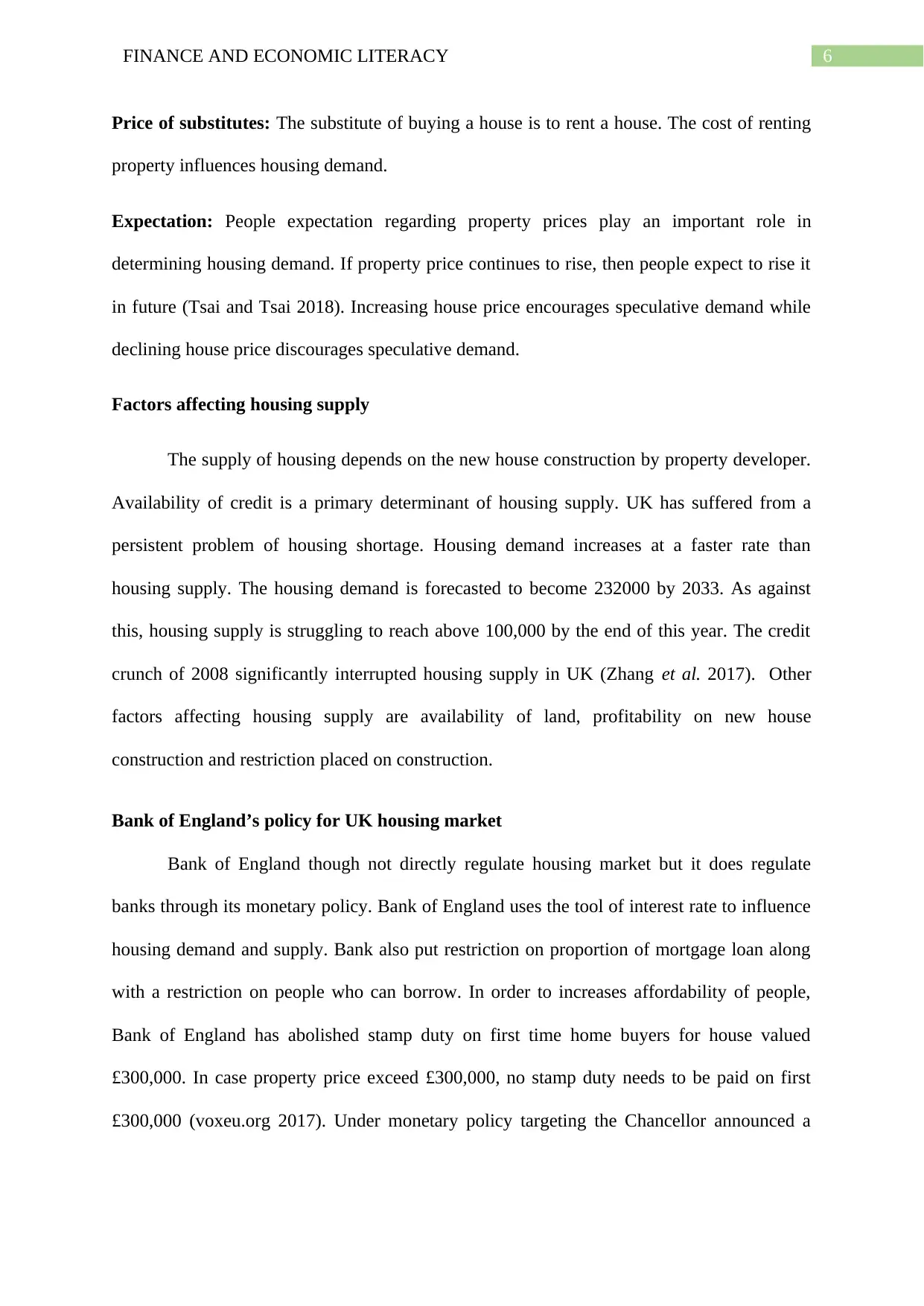
6FINANCE AND ECONOMIC LITERACY
Price of substitutes: The substitute of buying a house is to rent a house. The cost of renting
property influences housing demand.
Expectation: People expectation regarding property prices play an important role in
determining housing demand. If property price continues to rise, then people expect to rise it
in future (Tsai and Tsai 2018). Increasing house price encourages speculative demand while
declining house price discourages speculative demand.
Factors affecting housing supply
The supply of housing depends on the new house construction by property developer.
Availability of credit is a primary determinant of housing supply. UK has suffered from a
persistent problem of housing shortage. Housing demand increases at a faster rate than
housing supply. The housing demand is forecasted to become 232000 by 2033. As against
this, housing supply is struggling to reach above 100,000 by the end of this year. The credit
crunch of 2008 significantly interrupted housing supply in UK (Zhang et al. 2017). Other
factors affecting housing supply are availability of land, profitability on new house
construction and restriction placed on construction.
Bank of England’s policy for UK housing market
Bank of England though not directly regulate housing market but it does regulate
banks through its monetary policy. Bank of England uses the tool of interest rate to influence
housing demand and supply. Bank also put restriction on proportion of mortgage loan along
with a restriction on people who can borrow. In order to increases affordability of people,
Bank of England has abolished stamp duty on first time home buyers for house valued
£300,000. In case property price exceed £300,000, no stamp duty needs to be paid on first
£300,000 (voxeu.org 2017). Under monetary policy targeting the Chancellor announced a
Price of substitutes: The substitute of buying a house is to rent a house. The cost of renting
property influences housing demand.
Expectation: People expectation regarding property prices play an important role in
determining housing demand. If property price continues to rise, then people expect to rise it
in future (Tsai and Tsai 2018). Increasing house price encourages speculative demand while
declining house price discourages speculative demand.
Factors affecting housing supply
The supply of housing depends on the new house construction by property developer.
Availability of credit is a primary determinant of housing supply. UK has suffered from a
persistent problem of housing shortage. Housing demand increases at a faster rate than
housing supply. The housing demand is forecasted to become 232000 by 2033. As against
this, housing supply is struggling to reach above 100,000 by the end of this year. The credit
crunch of 2008 significantly interrupted housing supply in UK (Zhang et al. 2017). Other
factors affecting housing supply are availability of land, profitability on new house
construction and restriction placed on construction.
Bank of England’s policy for UK housing market
Bank of England though not directly regulate housing market but it does regulate
banks through its monetary policy. Bank of England uses the tool of interest rate to influence
housing demand and supply. Bank also put restriction on proportion of mortgage loan along
with a restriction on people who can borrow. In order to increases affordability of people,
Bank of England has abolished stamp duty on first time home buyers for house valued
£300,000. In case property price exceed £300,000, no stamp duty needs to be paid on first
£300,000 (voxeu.org 2017). Under monetary policy targeting the Chancellor announced a
Paraphrase This Document
Need a fresh take? Get an instant paraphrase of this document with our AI Paraphraser
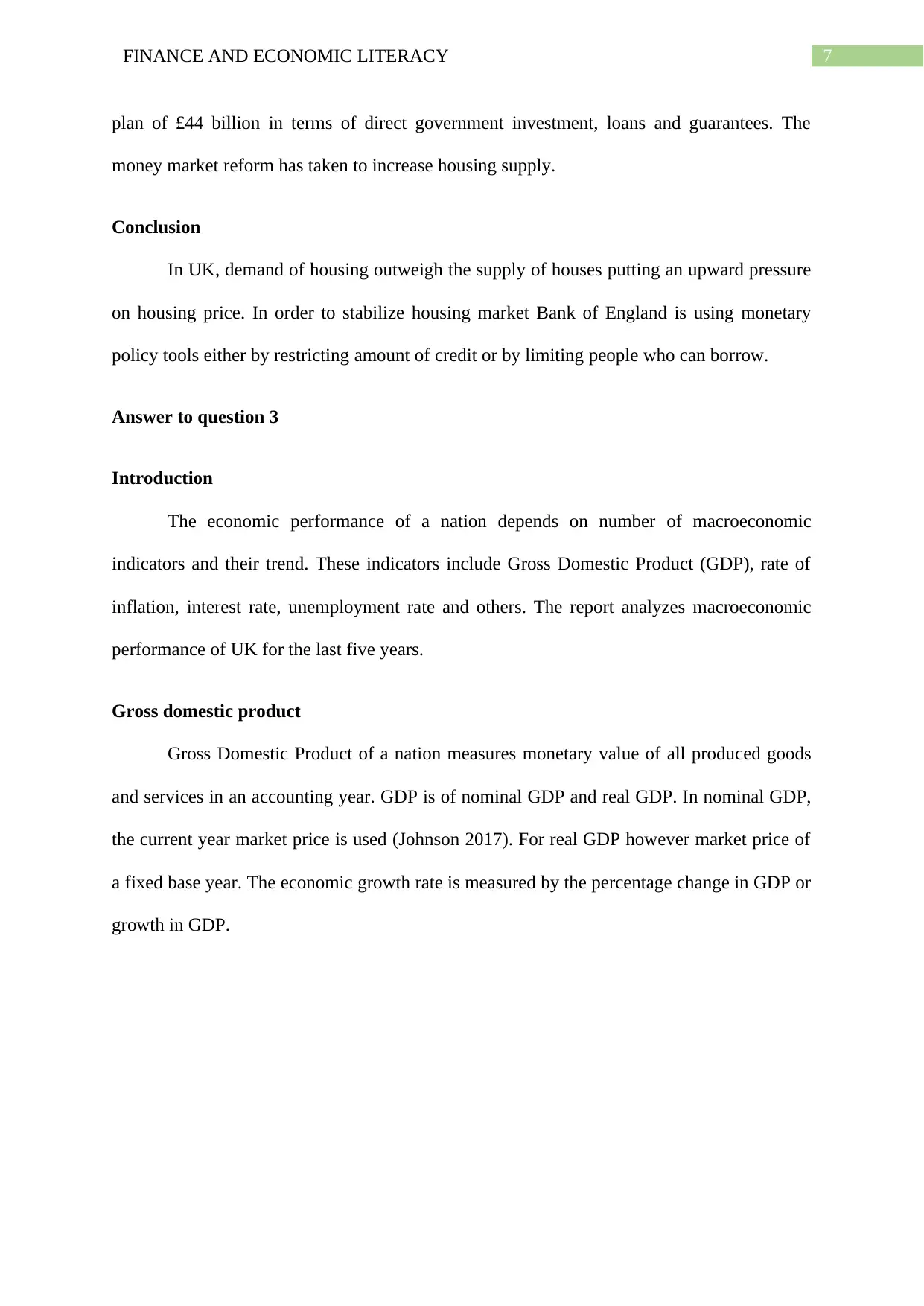
7FINANCE AND ECONOMIC LITERACY
plan of £44 billion in terms of direct government investment, loans and guarantees. The
money market reform has taken to increase housing supply.
Conclusion
In UK, demand of housing outweigh the supply of houses putting an upward pressure
on housing price. In order to stabilize housing market Bank of England is using monetary
policy tools either by restricting amount of credit or by limiting people who can borrow.
Answer to question 3
Introduction
The economic performance of a nation depends on number of macroeconomic
indicators and their trend. These indicators include Gross Domestic Product (GDP), rate of
inflation, interest rate, unemployment rate and others. The report analyzes macroeconomic
performance of UK for the last five years.
Gross domestic product
Gross Domestic Product of a nation measures monetary value of all produced goods
and services in an accounting year. GDP is of nominal GDP and real GDP. In nominal GDP,
the current year market price is used (Johnson 2017). For real GDP however market price of
a fixed base year. The economic growth rate is measured by the percentage change in GDP or
growth in GDP.
plan of £44 billion in terms of direct government investment, loans and guarantees. The
money market reform has taken to increase housing supply.
Conclusion
In UK, demand of housing outweigh the supply of houses putting an upward pressure
on housing price. In order to stabilize housing market Bank of England is using monetary
policy tools either by restricting amount of credit or by limiting people who can borrow.
Answer to question 3
Introduction
The economic performance of a nation depends on number of macroeconomic
indicators and their trend. These indicators include Gross Domestic Product (GDP), rate of
inflation, interest rate, unemployment rate and others. The report analyzes macroeconomic
performance of UK for the last five years.
Gross domestic product
Gross Domestic Product of a nation measures monetary value of all produced goods
and services in an accounting year. GDP is of nominal GDP and real GDP. In nominal GDP,
the current year market price is used (Johnson 2017). For real GDP however market price of
a fixed base year. The economic growth rate is measured by the percentage change in GDP or
growth in GDP.
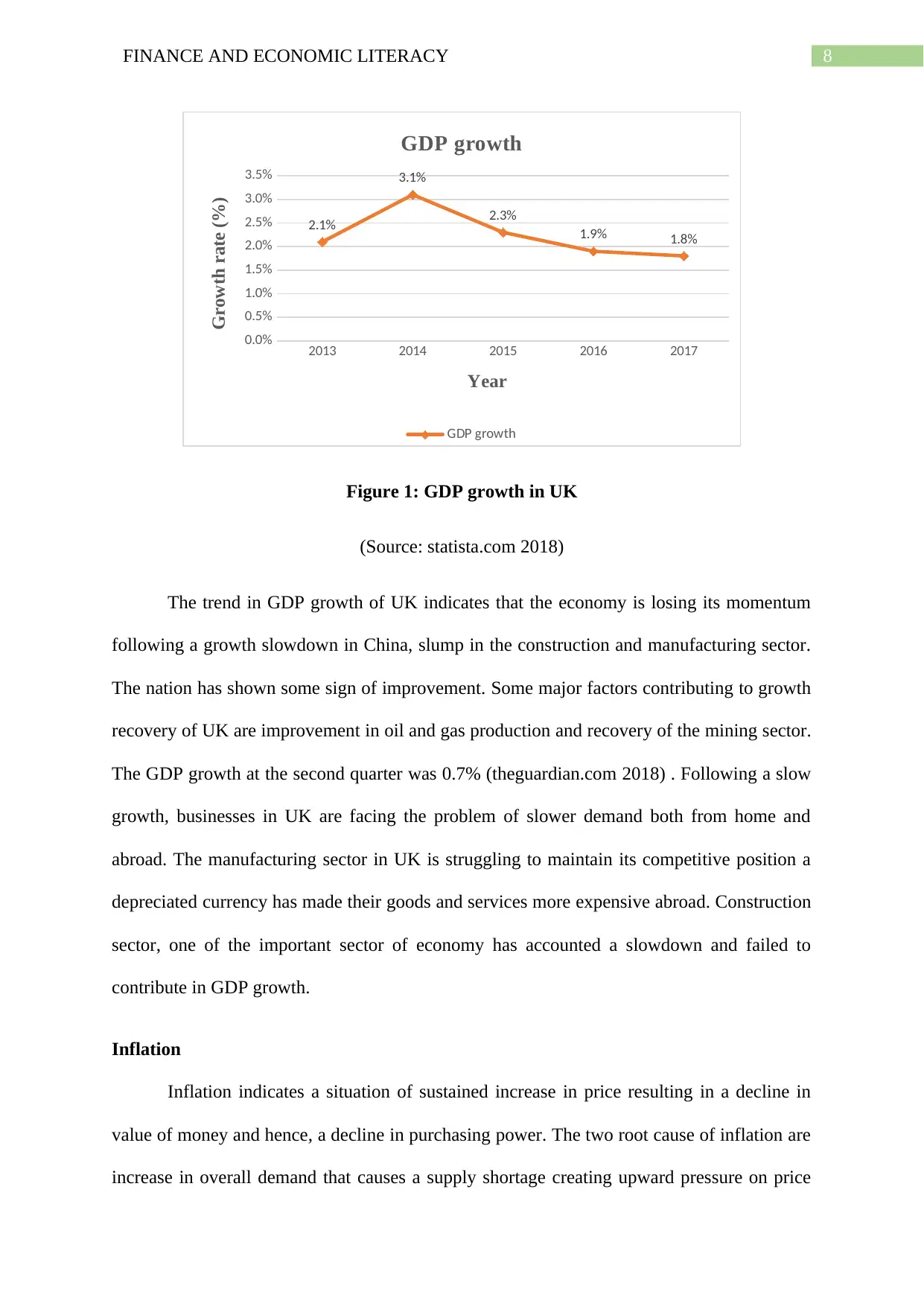
8FINANCE AND ECONOMIC LITERACY
2013 2014 2015 2016 2017
0.0%
0.5%
1.0%
1.5%
2.0%
2.5%
3.0%
3.5%
2.1%
3.1%
2.3%
1.9% 1.8%
GDP growth
GDP growth
Year
Growth rate (%)
Figure 1: GDP growth in UK
(Source: statista.com 2018)
The trend in GDP growth of UK indicates that the economy is losing its momentum
following a growth slowdown in China, slump in the construction and manufacturing sector.
The nation has shown some sign of improvement. Some major factors contributing to growth
recovery of UK are improvement in oil and gas production and recovery of the mining sector.
The GDP growth at the second quarter was 0.7% (theguardian.com 2018) . Following a slow
growth, businesses in UK are facing the problem of slower demand both from home and
abroad. The manufacturing sector in UK is struggling to maintain its competitive position a
depreciated currency has made their goods and services more expensive abroad. Construction
sector, one of the important sector of economy has accounted a slowdown and failed to
contribute in GDP growth.
Inflation
Inflation indicates a situation of sustained increase in price resulting in a decline in
value of money and hence, a decline in purchasing power. The two root cause of inflation are
increase in overall demand that causes a supply shortage creating upward pressure on price
2013 2014 2015 2016 2017
0.0%
0.5%
1.0%
1.5%
2.0%
2.5%
3.0%
3.5%
2.1%
3.1%
2.3%
1.9% 1.8%
GDP growth
GDP growth
Year
Growth rate (%)
Figure 1: GDP growth in UK
(Source: statista.com 2018)
The trend in GDP growth of UK indicates that the economy is losing its momentum
following a growth slowdown in China, slump in the construction and manufacturing sector.
The nation has shown some sign of improvement. Some major factors contributing to growth
recovery of UK are improvement in oil and gas production and recovery of the mining sector.
The GDP growth at the second quarter was 0.7% (theguardian.com 2018) . Following a slow
growth, businesses in UK are facing the problem of slower demand both from home and
abroad. The manufacturing sector in UK is struggling to maintain its competitive position a
depreciated currency has made their goods and services more expensive abroad. Construction
sector, one of the important sector of economy has accounted a slowdown and failed to
contribute in GDP growth.
Inflation
Inflation indicates a situation of sustained increase in price resulting in a decline in
value of money and hence, a decline in purchasing power. The two root cause of inflation are
increase in overall demand that causes a supply shortage creating upward pressure on price
⊘ This is a preview!⊘
Do you want full access?
Subscribe today to unlock all pages.

Trusted by 1+ million students worldwide

9FINANCE AND ECONOMIC LITERACY
and an increase in production cost. The former is called demand-pull inflation while the latter
is known as cost-push inflation (Mankiw 2014).
2013 2014 2015 2016 2017 2018
0.00
0.50
1.00
1.50
2.00
2.50
3.00 2.57
1.46
0.04
0.68
2.68 2.85
Inflation rate
Inflation rate
Year
Inflation rate (%)
Figure 2: Inflation trend in UK
(Source: statista.com 2018)
In the past few years, inflation rate in UK has recorded a sharp increase. In December,
inflation has slightly dropped to 3% from 3.1% in November. A major factor contributing to
rising inflation in UK is the increased cost of import following a devaluation of pound. When
inflation in goods sector is taken separately from service sector then it is 3.4% higher than it
had been for more than five years (bbc.com 2018).
Interest rate
Interest rate determines the level of investment in an economy. In order to overcome
the slow growth, rate the Bank of England has set interest rate to a relatively low level.
However, in 2017 because of an upward pressure on price level the bank has decided to raise
the interest rate to 0.5% from 0.25% (bbc.com 2018). This is the first increase in the official
interest rate since July 2007.
and an increase in production cost. The former is called demand-pull inflation while the latter
is known as cost-push inflation (Mankiw 2014).
2013 2014 2015 2016 2017 2018
0.00
0.50
1.00
1.50
2.00
2.50
3.00 2.57
1.46
0.04
0.68
2.68 2.85
Inflation rate
Inflation rate
Year
Inflation rate (%)
Figure 2: Inflation trend in UK
(Source: statista.com 2018)
In the past few years, inflation rate in UK has recorded a sharp increase. In December,
inflation has slightly dropped to 3% from 3.1% in November. A major factor contributing to
rising inflation in UK is the increased cost of import following a devaluation of pound. When
inflation in goods sector is taken separately from service sector then it is 3.4% higher than it
had been for more than five years (bbc.com 2018).
Interest rate
Interest rate determines the level of investment in an economy. In order to overcome
the slow growth, rate the Bank of England has set interest rate to a relatively low level.
However, in 2017 because of an upward pressure on price level the bank has decided to raise
the interest rate to 0.5% from 0.25% (bbc.com 2018). This is the first increase in the official
interest rate since July 2007.
Paraphrase This Document
Need a fresh take? Get an instant paraphrase of this document with our AI Paraphraser

10FINANCE AND ECONOMIC LITERACY
Figure 3: Movement of interest rate
(Source: bbc.com 2018)
Unemployment
Unemployment rate indicates the condition of labor market in the economy.
Unemployment rate in UK has declined to a 4.3 percent in the month of January, 2018
(tradingeconomics.com 2018). With a decline in unemployment the average weekly earnings
of people in nominal terms is increased by 2.6 percent.
Figure 4: Unemployment in United Kingdom
(Source: tradingeconomics.com 2018)
Figure 3: Movement of interest rate
(Source: bbc.com 2018)
Unemployment
Unemployment rate indicates the condition of labor market in the economy.
Unemployment rate in UK has declined to a 4.3 percent in the month of January, 2018
(tradingeconomics.com 2018). With a decline in unemployment the average weekly earnings
of people in nominal terms is increased by 2.6 percent.
Figure 4: Unemployment in United Kingdom
(Source: tradingeconomics.com 2018)
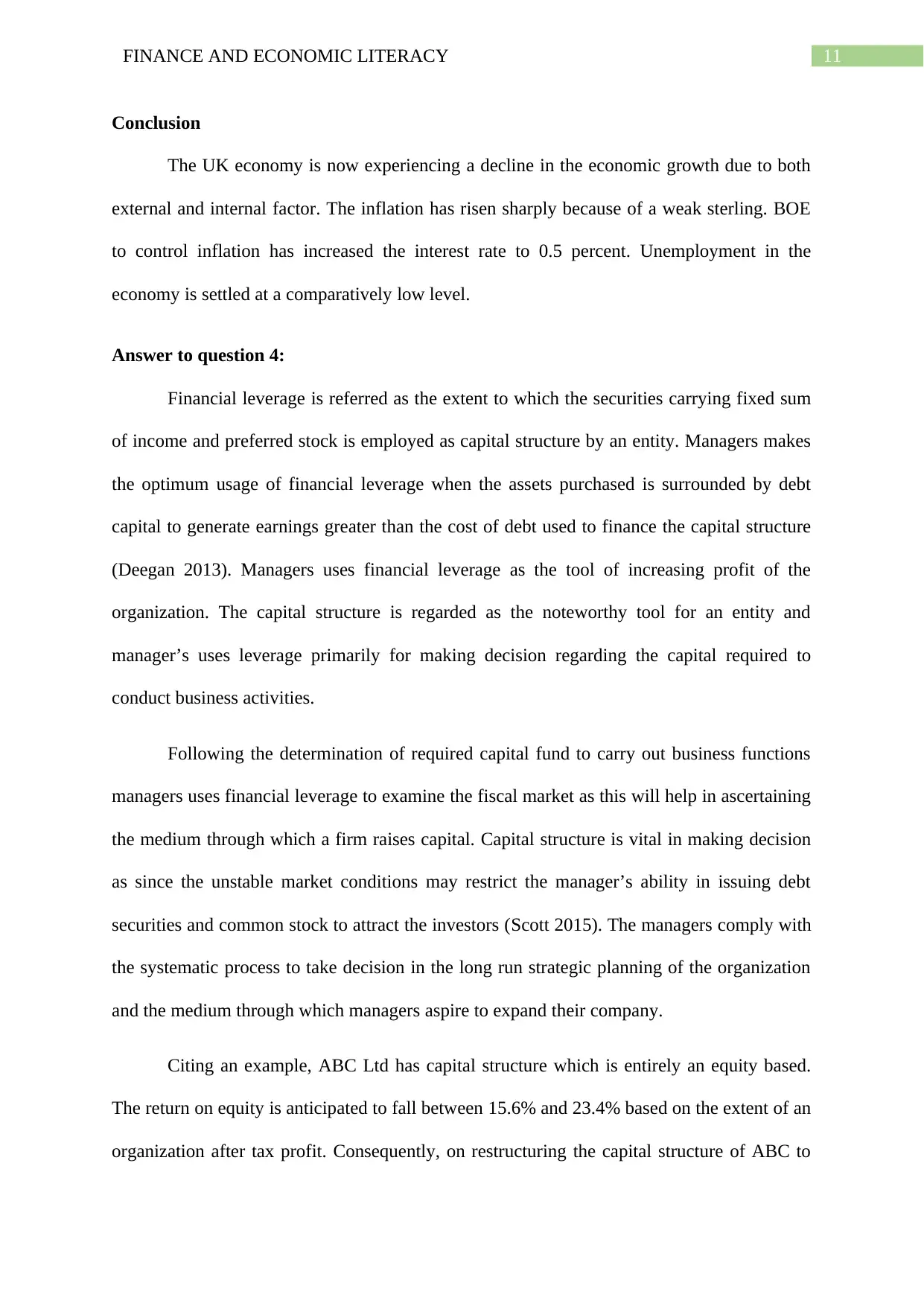
11FINANCE AND ECONOMIC LITERACY
Conclusion
The UK economy is now experiencing a decline in the economic growth due to both
external and internal factor. The inflation has risen sharply because of a weak sterling. BOE
to control inflation has increased the interest rate to 0.5 percent. Unemployment in the
economy is settled at a comparatively low level.
Answer to question 4:
Financial leverage is referred as the extent to which the securities carrying fixed sum
of income and preferred stock is employed as capital structure by an entity. Managers makes
the optimum usage of financial leverage when the assets purchased is surrounded by debt
capital to generate earnings greater than the cost of debt used to finance the capital structure
(Deegan 2013). Managers uses financial leverage as the tool of increasing profit of the
organization. The capital structure is regarded as the noteworthy tool for an entity and
manager’s uses leverage primarily for making decision regarding the capital required to
conduct business activities.
Following the determination of required capital fund to carry out business functions
managers uses financial leverage to examine the fiscal market as this will help in ascertaining
the medium through which a firm raises capital. Capital structure is vital in making decision
as since the unstable market conditions may restrict the manager’s ability in issuing debt
securities and common stock to attract the investors (Scott 2015). The managers comply with
the systematic process to take decision in the long run strategic planning of the organization
and the medium through which managers aspire to expand their company.
Citing an example, ABC Ltd has capital structure which is entirely an equity based.
The return on equity is anticipated to fall between 15.6% and 23.4% based on the extent of an
organization after tax profit. Consequently, on restructuring the capital structure of ABC to
Conclusion
The UK economy is now experiencing a decline in the economic growth due to both
external and internal factor. The inflation has risen sharply because of a weak sterling. BOE
to control inflation has increased the interest rate to 0.5 percent. Unemployment in the
economy is settled at a comparatively low level.
Answer to question 4:
Financial leverage is referred as the extent to which the securities carrying fixed sum
of income and preferred stock is employed as capital structure by an entity. Managers makes
the optimum usage of financial leverage when the assets purchased is surrounded by debt
capital to generate earnings greater than the cost of debt used to finance the capital structure
(Deegan 2013). Managers uses financial leverage as the tool of increasing profit of the
organization. The capital structure is regarded as the noteworthy tool for an entity and
manager’s uses leverage primarily for making decision regarding the capital required to
conduct business activities.
Following the determination of required capital fund to carry out business functions
managers uses financial leverage to examine the fiscal market as this will help in ascertaining
the medium through which a firm raises capital. Capital structure is vital in making decision
as since the unstable market conditions may restrict the manager’s ability in issuing debt
securities and common stock to attract the investors (Scott 2015). The managers comply with
the systematic process to take decision in the long run strategic planning of the organization
and the medium through which managers aspire to expand their company.
Citing an example, ABC Ltd has capital structure which is entirely an equity based.
The return on equity is anticipated to fall between 15.6% and 23.4% based on the extent of an
organization after tax profit. Consequently, on restructuring the capital structure of ABC to
⊘ This is a preview!⊘
Do you want full access?
Subscribe today to unlock all pages.

Trusted by 1+ million students worldwide
1 out of 18
Related Documents
Your All-in-One AI-Powered Toolkit for Academic Success.
+13062052269
info@desklib.com
Available 24*7 on WhatsApp / Email
![[object Object]](/_next/static/media/star-bottom.7253800d.svg)
Unlock your academic potential
Copyright © 2020–2025 A2Z Services. All Rights Reserved. Developed and managed by ZUCOL.




